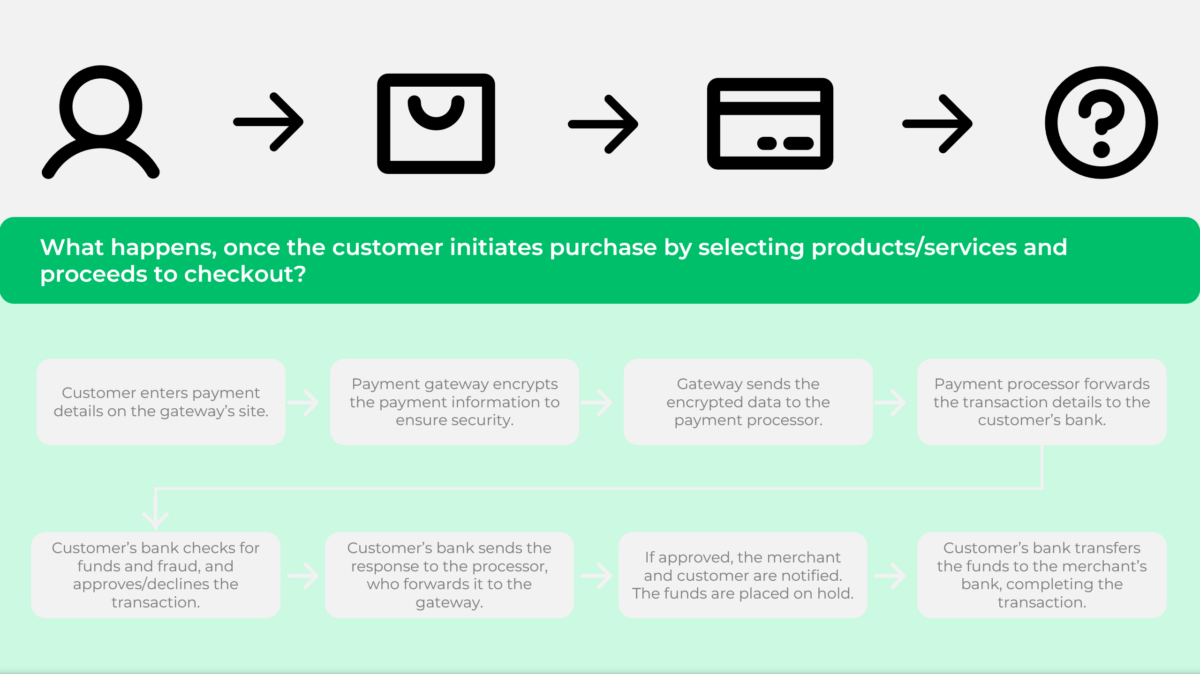
With our world becoming increasingly cashless, technologies like payment gateways can greatly simplify and expedite payments, benefiting consumers and businesses alike. And this is crucial, considering that by 2025, online transaction values are estimated to grow by as much as 15%.
Before you select the most appropriate gateway for your business, however, let’s make sure you understand what they are, how they work, and what you should look for in a quality solution.
Gateway payment fundamentals for modern businesses
The reason why gateway payments are such a keystone when it comes to daily business operations is the role they play in securely facilitating online transactions between customers and merchants. More specifically, they encrypt sensitive information like credit card details, ensuring safe data transfers over the internet, thereby building trust and reducing the risk of fraud.
Moreover, by supporting a wide range of payment methods like credit/debit cards and digital wallets, payment gateways enhance convenience and expand the customer reach that businesses enjoy. This crucial technology also enables quick and reliable payment processing (a vital feature for maintaining cash flow), as well as improves financial management and operational efficiency by seamlessly integrating with different accounting systems.
What is a payment gateway?
A payment gateway is a technology that enables secure processing of online transactions between customers and merchants. With a payment gateway, businesses are enabled to accept card payments, offer a variety of payment methods to customers, secure their financial transactions, accept bank payments, and more. Payment gateways act as intermediaries, encrypting and transmitting payment information from a customer’s device to the acquiring bank. Technologically, payment gateways use Secure Socket Layer (SSL) encryption to protect data during transmission. They interact with the merchant’s website through Application Programming Interfaces (APIs) to handle transaction requests.
This process involves three basic steps:
- Authorisation: Verifying payment details with the issuing bank.
- Authentication: Ensuring the transaction’s legitimacy.
- Settlement: Transferring funds from the customer’s bank to the merchant’s account.
Payment gateways support various payment methods and comply with standards like PCI-DSS to ensure security and reliability. They also often use tokenization to replace sensitive card information with unique tokens, further enhancing security and reducing the risk of fraud.
What’s the difference between payment processor and payment gateway?
The short answer: a payment processor is a company that handles transactions between customer and merchant banks, while a payment gateway is a technology designed to transmit payment information from customers to payment processors.
The slightly longer answer:
- A payment processor handles the transaction between the customer’s bank and the merchant’s bank, ensuring the payment is completed. It facilitates the authorisation, processing, and settlement of credit card or debit card transactions.
- A payment gateway is a technology for securely transmitting payment information from customers to payment processors. As an intermediary between the merchant’s website and the payment processor, it encrypts sensitive data to ensure secure transactions.
In other words, payment processors manage the actual transaction and the transfer of funds, while payment gateways provide a secure interface for the transaction to take place in the first place.
Payment gateways types
Given the needs of different types of transaction, payment gateways don’t simply act in the same way regardless of context.
Hosted gateways, provided by third-party services, are used for off-site payments, where customers are redirected to the payment service provider’s platform to enter their payment details and complete the transaction. Afterwards, they’re sent back to the business website. Hosted gateways are easy to integrate and secure, but don’t allow businesses to retain control of the customer experience.
Self-hosted gateways, as the name suggests, enable businesses to collect transaction data on their own websites, and to have full control over the checkout process and customer experience. The downside is that, when the gateway is self-hosted, the companies using them are required to comply with data protection standards like the PCI DSS, which can make a dent in their bottom lines.
API-hosted gateways collect payment details via an API, and provide businesses with a seamlessly integrated and simple checkout process, but, just like with self-hosted gateways, requires them to ensure regulatory compliance on their own dime. In this case, it means ensuring a secure cardholder data environment,
Local bank integration is a great option for companies targeting specific regions and countries, as they connect directly with the bank’s proprietary payment system. This is an advantage in cases where the bank is widely known and trusted by customers. The main challenge with this type of gateway is the varying technological infrastructures of different banks and their bandwidth for online transactions.
How do payment gateways work?
Probably the easiest and clearest way to explain this is to simply break down the entire transaction cycle, going step-by-step. Here’s how it goes:
- Customer initiates purchase by selecting products/services and proceeds to checkout.
- Customer enters payment details on the gateway’s site.
- Payment gateway encrypts the payment information to ensure security.
- Gateway sends the encrypted data to the payment processor.
- Payment processor forwards the transaction details to the customer’s bank.
- Customer’s bank checks for funds and fraud, and approves/declines the transaction.
- Customer’s bank sends the response to the processor, who forwards it to the gateway.
- If approved, the merchant and customer are notified. The funds are placed on hold.
- Customer’s bank transfers the funds to the merchant’s bank, completing the transaction.

The advantages of gateway payments
One of the key advantages of gateway payments is the extra security they provide for transactions by using robust encryption and fraud detection measures. This also helps with reducing the risk of data breaches.
Gateway payments are also favoured by companies seeking to maximise user experience (which is to say, most companies nowadays). Since a seamless and reliable payment process is something that customers have come to expect, providing them with exactly that helps build trust and encourages repeat business.
We’d be remiss if we didn’t also mention that gateway payments have the virtue of supporting multiple payment methods, including credit/debit cards, digital wallets, and international payments. This is great for businesses that cater to diverse customer bases and want to expand their market reach.
Implementing gateway payments in your business
When choosing a payment gateway for your business, make sure it supports the payment methods favoured by your customers, and smoothly integrates with your current tech systems. Also, make sure you thoroughly understand the fee structure, and only consider gateways that offer strong security measures and flexibility in managing your merchant account (including multi-currency support).
What makes ConnectPay in particular so great is that it supports a wide range of currencies and payment methods, as well as offers transparent fees, and advanced security.
In addition to having a great track record for reliability and excellent customer service, ConnectPay is also super easy to integrate via API with all the major e-commerce platforms. Here’s what the entire process entails:
- Register for a ConnectPay account.
- Access the API documentation from the ConnectPay dashboard.
- For supported platforms, install the ConnectPay plugin.
- For custom sites, integrate using provided API keys.
- Configure payment settings in your system.
- Test transactions in sandbox mode.
- Switch to live mode and start processing payments.
Quick and easy!
Security protocols and compliance in gateway payments
For security, gateways use encryption to secure data during transmission, as well as fraud-detection measures to identify and prevent suspicious activities, tokenization (replacing sensitive card information with a unique identifier), and 3D secure authentication to shield online transactions with an extra layer of protection. Furthermore, payment gateways are required to comply with standards like the PCI DSS, and conduct regular audits and updates to keep up with any newly emerging threats.
For our part, in addition to all of the above features, we offer embedded compliance. This means that our trusted team of experts handle AML/KYC requirements, as well as compliance with regulations like the GDPR on behalf of our clients. Which is to say, with ConnectPay, regulatory compliance is part of the package!
Payment gateway fraud: Protect your business
Unauthorised transactions via a payment gateway can occur through various means such as stolen card card information, identity theft, phishing, or hacking by fraudsters exploiting vulnerabilities in the payment process.
Since a payment gateway is an intermediary that connects the merchant and its customers, before they can succeed, fraudsters must find a way to circumvent the fraud-detection measures used by the relevant gateway – this is why prioritising security is so important.
Common payment gateway fraud examples
Here are the most common forms of payment gateway fraud:
- Card-not-Present (CNP) fraud: Unauthorised transactions made using stolen card details online or via phone.
- Phishing: Tricking customers into revealing sensitive information through fake websites or emails.
- Identity theft: Using stolen personal information to make fraudulent transactions.
- Chargeback fraud: Falsely claiming a legitimate transaction as unauthorised to get a refund.
- Account takeover: Gaining access to and misusing a customer’s payment account.
- Transaction laundering: Processing the transactions of an illegal business through a legitimate merchant account.
- Friendly fraud: Disputing a charge imposed by a merchant that the customer initially approved.
- Skimming: Stealing card information through devices attached to card readers.
- Refund fraud: Making purchases with stolen cards and then requesting refunds to a different account.
- Merchant fraud: Charging customers without delivering goods/services.
Because of that, safeguarding your card details is crucial. Please review our fraud prevention guide here: https://connectpay.com/The-Fraud-Memo.pdf.
The importance of a gateway for SaaS and subscription companies
Recurring payments involve automatically charging customers at regular intervals, requiring secure storage of payment details, accurate billing, and handling of expirations or changes in payment methods.
With payment gateways, you can easily make and collect recurring payments and manage these complexities through secure storage of payment information, automated billing cycles, and tools facilitating the process of adapting to subscription changes.
Some common challenges (and ConnectPay’s solutions to them):
- Payment failures: ConnectPay offers retry logic and alerts for failed payments.
- Security: Advanced encryption and PCI DSS compliance ensure data protection.
- Customer management: Easy subscription management and update tools.
- Compliance: Ensures adherence to regulatory requirements for recurring billing.
The importance of a gateway for platforms and marketplaces
Since platform and marketplace payments involve multiple parties, complex fee structures, and split payments, managing these requires handling many different currencies, compliance issues, and security concerns.
Picking the right gateway will enable your business to automate split payment, conduct multi-currency transactions, and ensure regulatory compliance with ease.
Some common challenges (and ConnectPay’s solutions to them):
- Split payments: ConnectPay automates payments split among several parties.
- Multi-currency transactions: Supports a wide range of currencies.
- Compliance: Ensures PCI DSS compliance and uses advanced encryption.
- Fee management: Transparently manages complex fee structures and payouts.
Addressing the challenges of gateway payments
Just like everything else, payment gateways aren’t perfect, and issues do arise from time to time. Here’s a short list of the most common ones (including solutions) and how ConnectPay deals with them:
| Challenge | Solution | ConnectPay’s approach |
| Transaction failures | Ensure robust connectivity and retry mechanisms. | Employs automatic retries and real-time transaction monitoring. |
| Slow processing times | Optimise infrastructure for speed and efficiency. | Uses advanced technology for fast, reliable processing. |
| Integration difficulties | Simplify API and provide comprehensive support. | Offers easy-to-use APIs and extensive integration support. |
| Security concerns | Implement strong encryption and fraud prevention. | Utilises advanced encryption and sophisticated fraud detection. |
| Customer support | Provide accessible and responsive support. | Delivers 24/7 customer support and dedicated account management |
Interested in ConnectPay’s payment gateway solutions?
ConnectPay is an all-in-one financial platform designed with online businesses in mind. We offer multi-currency and cross-border payments, built-in regulatory compliance, 24/7 support, a wide range of payment cards (including virtual and white-label), hassle-free embedding of service via an API – and more.
Needless to say, we’re also here to help you with integrating gateway payments and provide any other type of assistance your business may need. If you’re interested, don’t hesitate to drop us a line and we’ll get back to you as soon as possible!







